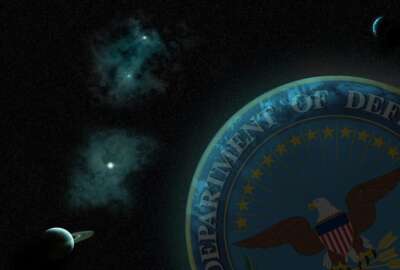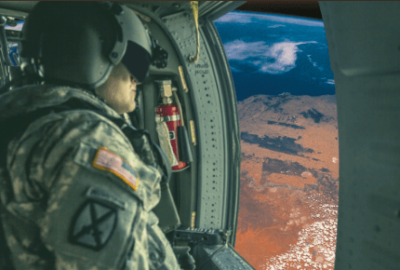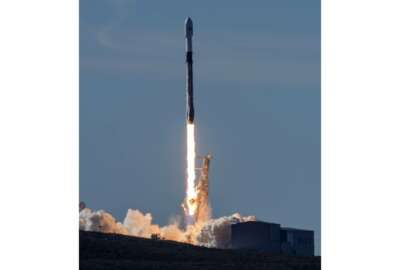
Space Force to require all of its employees to be digitally fluent
Lt. Gen. David Thompson, the vice commander of the U.S. Space Force, said the service is creating a new training curriculum to make sure employees have a minimum...
Eventually the U.S. Space Force will be 6,700 persons strong and they all will have to be digitally fluent. That means, all employees must pass a minimum level of training to prove their knowledge, skills and capabilities.
Air Force Maj. Gen. Kim Crider, the mobilization assistant to the chief of Space Operations, is developing a strategy to that leans on the service’s Digital University to create that minimum level of education Space Force servicemembers and civilians will need to have.
Crider’s plan is due to Space Force Chief of Space Operations, Gen.John Raymond later this fall, said Lt. Gen. David Thompson, the vice commander of the U.S. Space Force, Thursday during the Space Warfighting Industry Forum sponsored by the National Defense Industrial Association (NDIA).

“She has been charged with creating a plan to create a digital service,” Thompson said. “She’s created an approach … a level of training and education in digital topics, it may be programming, it may be networks, but it’s a whole host of IT and digital types of education. She is establishing a core set of knowledge and training activities that every single member of the Space Force will be required when it comes to digital. She’s also creating a structure by which rebuilding the requirements inside the Space Force for programmers and experts in terms of data management and data manipulation.”
This training and knowledge also could lead to a higher rate of pay for Space Force members.
Thompson said Crider is developing this concept similar to how the Air Force pays extra to those servicemembers with certain language skills.
Crider also is focused on creating a digital headquarters from a process and procedure perspective that doesn’t rely on paper or disparate, disconnected systems.
“Another one of the elements she’s building on is a pure digital strategy. How we handle our data, how we process our data, how we expose our data and how we allow others access to and manipulate the data,” he said. “She already is full and deep in terms of having built and execute a strategy to make us a digital service.”
New approach to hiring, recruiting
What Crider is doing is laying a piece to the broader foundation that eventually will become the full Space Force.
Thompson said the digital force is part of how the Space Force is rethinking its broader approach to talent management and human capital.
“The vision set out by Gen. Raymond and Secretary [Barbara] Barrett is the ability to take in not just what I’ll call the traditional sorts of persons and personalities who you find in the military services, but the opportunity to step out and look for new and different sort of person, look for them in different places, look for different skillsets for this specific domain and this specific mission set,” he said. “We want to look for the opportunity, if we can, to allow for a more easy and free flow of expertise between the military sector, the civilian sector, the commercial sector and the industry sector. We want to see if we can find a way to manage this force, to inspire this force and to retain this force that keeps them interested, active and fresh over the course of a career.”
He said a sprint team is reviewing the latest version of this human capital and talent management strategy.
Space Force will need a new approach to talent management as the response to join the new service has been overwhelming.
The service in May put out a call for airmen and women to fill those 6,700 positions. Thompson said almost 9,000 people volunteered to join the service.
“The first of those transferees will transfer into the service in September. Those will be members of the core space operations career field inside the Air Force. Then as we finish going through and evaluating the volunteers in engineering, program management, cyberspace operations, intelligence and other things, we will finalize those lists, agree to those transfers and sometime in very early 2021 that next group will transfer in.”
Most functions transferred
President Donald Trump initially called on the Pentagon to create draft legislation for the Space Force in February 2019.
Congress followed in December 2019 by creating the Space Force in the fiscal 2020 National Defense Authorization Act as a new military service and it would reside within the Department of the Air Force, in much the same way the Marine Corps operates as a service in the Navy Department.
Over the last eight months, the Space Force leadership has been creating the new service. In July, it released its first doctrine outlining five areas it needs to excel in order to succeed.
Thompson said the Pentagon has been preparing for the full launch of Space Force for more than a year.
“The Secretary of the Air Force approved the transfer of functions and organization from the rest of the Air Force into the U.S. Space Force,” he said. “In March, the Secretary of the Air Force approved the list of transfer organization and transfer functions and she gave us 180 days to accomplish that transfer. I can tell you effective today, which is about 30-plus days early from that September date when we had to have all those units transferred. We have completed and approved all the conditions required for the transfer of 21 of the 23 elements. So that part of the task is complete. Two of the intelligence squadrons associated with the National Air and Space Intelligence Center require more complex coordination throughout the intelligence community. It wasn’t a matter of the Air Force taking action and we are in the final stages of coordinating what that transfer of function and responsibility for those last two organizations.”
Copyright © 2024 Federal News Network. All rights reserved. This website is not intended for users located within the European Economic Area.
Jason Miller is executive editor of Federal News Network and directs news coverage on the people, policy and programs of the federal government.
Follow @jmillerWFED







